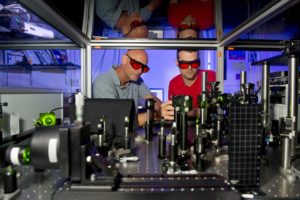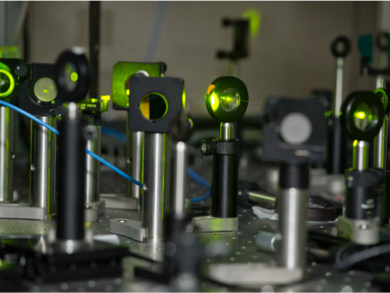Research in the Hartland Laboratory is currently supported by the National Science Foundation through the MSN and CMI programs (CHE-2002300 and CHE-1902403), and the Department of Energy through a SBIR Phase IIb grant with Photothermal Spectroscopy Corp.

Recent projects and associated papers:
Ultrafast Spectroscopy Studies of Single Nanostructures:
We use transient absorption microscopy to study energy transport and relaxation process in single nanostuctures. Current research in this area includes studies of how the breathing modes of nanoparticles dissipate their energy into their environment, and the motion of plasmons and excitons in different types of nanostructures.
Kuai Yu, Yang Yang, Junzhong Wang, Gregory V. Hartland, Guo Ping Wang, “Nanoparticle-Fluid Interactions at Ultra-High Acoustic Vibration Frequencies Studied by Femtosecond Time- Resolved Microscopy”, ACS Nano 2021, 15, 1833-1840.
Tuphan Devkota, Kuai Yu and Gregory V. Hartland, “Mass Loading Effects in the Acoustic Modes of Gold Nanoplates”, Nanoscale, 2019, 11, 16208 – 16213.
Junzhong Wang, Yang Yang, Neng Wang, Kuai Yu, Gregory V. Hartland, and Guo Ping Wang, “Long Lifetime and Coupling of Acoustic Vibrations of Gold Nanoplates on Unsupported Thin Film” J. Phys. Chem. A, 2019, 123, 10339-10346.
Junzhong Wang, Kuai Yu, Yang Yang, Gregory V. Hartland, John E. Sader, Guo Ping Wang, “Strong Vibrational Coupling in Room Temperature Plasmonic Resonators”, Nature Communications, 2019, 10, 1527.
Gary Beane, Tuphan Devkota, Brendan S. Brown and Gregory V. Hartland, “Ultrafast Measurements of the Dynamics of Single Nanostructures: a Review”, Rep. Prog. Phys., 2019, 82, 016401.
Localized and Propagating Surface Plasmons Polaritons in Metal Nanostructures:
The field enhancements that are associated with surface plasmons are important in a number of technologies, including molecular sensing, surface enhanced spectroscopies and plasmon enhanced photocatalysis. The efficiencies of these processes depend on the dephasing times of the plasmons, which we study using single particle spectroscopy. We are interested in both the localized surface plasmon resonances of particles and propagating surface plasmons polaritons in extended metal nanostructures, such as nanowires and nanoplates.
Kyle Aleshire, Illia M. Pavlotec, Robyn Collette, Xiang-Tian Kong, Phillip D. Rack, Shubin Zhang, David J. Masiello, Jon P. Camden, Gregory V. Hartland, and Masaru Kuno, “Far-Field Mid-Infrared Imaging and Spectroscopy of Single High Aspect Ratio Gold Nanowires”, Proc. Nat. Acad. Sci. U.S.A., 2020, 117 (5), 2288-2293.
Brendan S. Brown and Gregory V. Hartland, “Chemical Interface Damping for Propagating Surface Plasmon Polaritons in Gold Nanostripes”, J. Chem. Phys., 2020, 152, 024707.
Tuphan Devkota, Brendan S. Brown, Gary Beane, Kuai Yu, and Gregory V. Hartland, “Making Waves: Radiation Damping in Metallic Nanostructures”, J. Chem. Phys. 2019, 151, 080901.
Gary Beane, Brendan S. Brown, Tuphan Devkota and Gregory V. Hartland, “Light-like Group Velocities and Long Lifetimes for Leaky Surface Plasmon Polaritons in Noble Metal Nanostripes”, J. Phys. Chem. C, 2019, 123, 15729-15737 (2019).
Gary Beane, Brendan Brown, Paul Johns, Tuphan Devkota, Gregory V. Hartland, “Strong Exciton-Plasmon Coupling in Silver Nanowire Nanocavities”, J. Phys. Chem. Letters, 2018, 9, 1676–1681.
New Optical Techniques for Studying Nanomaterials:
A major area of research in our lab is to develop new techniques to study nanomaterials. Recent efforts in this area include the development of super-resolution IR microscopy based on photothermal heterodyne imaging (a joint project with the Kuno group).
Zhongming Li, Kyle Aleshire, Masaru Kuno , and Gregory V. Hartland, “Super-Resolution Far-Field Infrared Imaging by Photothermal Heterodyne Imaging,” J. Phys. Chem. B, 2017, 21, 8838–8846.

